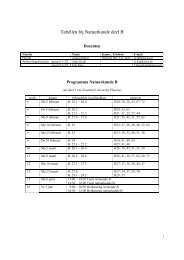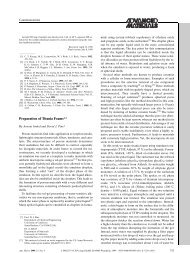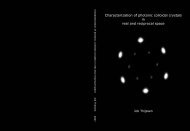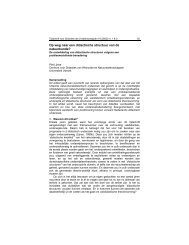Sedimentation Equilibrium of Mixtures of Charged Colloids
Sedimentation Equilibrium of Mixtures of Charged Colloids
Sedimentation Equilibrium of Mixtures of Charged Colloids
Create successful ePaper yourself
Turn your PDF publications into a flip-book with our unique Google optimized e-Paper software.
0.01ρ s=10 −3 Mρ s=10 −5 Mρ s=10 −6 Mρ s=10 −7 Mη0.00500 5 10 15 20x [cm]Figure 4.12: Imitation <strong>of</strong> figure 3 from [8]. Shown are the predicted packingfraction pr<strong>of</strong>iles η(x) = (π/6)ρ(x)σ 3 , in a sample <strong>of</strong> hight H = 20 cm, with anaverage packing fraction <strong>of</strong> 0.0005 for several salt concentrations ρ s . Theyare calculated by the Poisson-Boltzmann-method. The colloidal charge isZ = 200, the Bjerrum length λ B = 2.3nm (ethanol at room temperature),the gravitational length L = 2mm, and the colloidal diameter σ = 150nmfigures 4.14 and 4.15). If the total distribution reaches the top <strong>of</strong> the system,this effect will become stronger by entropy. In other words, by additionthe components would be restricted to increasingly narrow layers, which isenergetically expensive, due to the low entropy. Instead, the componentsform layers that overlap each other forming gaussian like density pr<strong>of</strong>iles,rather than linear ones. Related to the density, the electric field will not be astepwise function, but a smooth decaying function with height. Figure 4.16clarifies these arguments (earlier described in figures 4.9 and 4.10).4.6.4 The slope modelWhen the computers fail, it is always nice to have a method that can be doneby hand.The following model approximates the numerical results based on the Poisson-32








